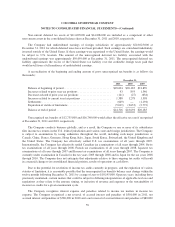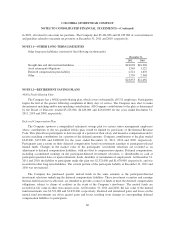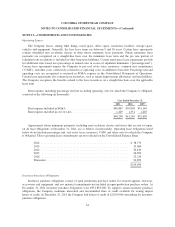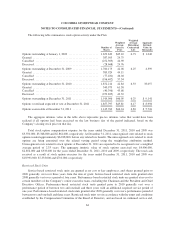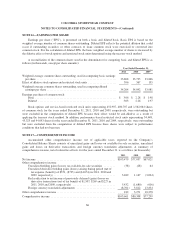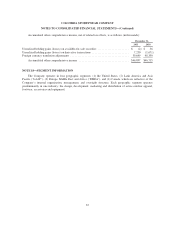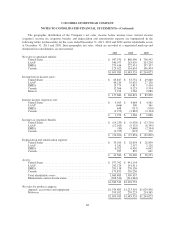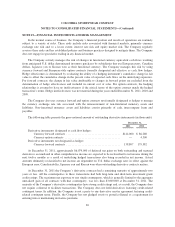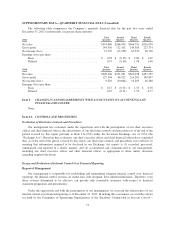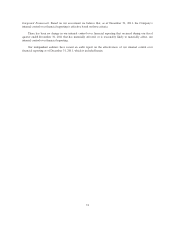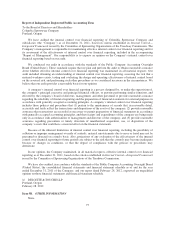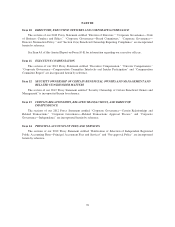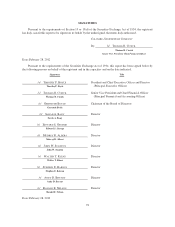Columbia Sportswear 2011 Annual Report Download - page 74
Download and view the complete annual report
Please find page 74 of the 2011 Columbia Sportswear annual report below. You can navigate through the pages in the report by either clicking on the pages listed below, or by using the keyword search tool below to find specific information within the annual report.
COLUMBIA SPORTSWEAR COMPANY
NOTES TO CONSOLIDATED FINANCIAL STATEMENTS—(Continued)
NOTE 19—FINANCIAL INSTRUMENTS AND RISK MANAGEMENT
In the normal course of business, the Company’s financial position and results of operations are routinely
subject to a variety of risks. These risks include risks associated with financial markets, primarily currency
exchange rate risk and, to a lesser extent, interest rate risk and equity market risk. The Company regularly
assesses these risks and has established policies and business practices designed to mitigate them. The Company
does not engage in speculative trading in any financial market.
The Company actively manages the risk of changes in functional currency equivalent cash flows resulting
from anticipated U.S. dollar denominated inventory purchases by subsidiaries that use European euros, Canadian
dollars, Japanese yen or Korean won as their functional currency. The Company manages this risk by using
currency forward and European-style option contracts formally designated and effective as cash flow hedges.
Hedge effectiveness is determined by evaluating the ability of a hedging instrument’s cumulative change in fair
value to offset the cumulative change in the present value of expected cash flows on the underlying exposures.
For forward contracts, the change in fair value attributable to changes in forward points are excluded from the
determination of hedge effectiveness and included in current cost of sales. For option contracts, the hedging
relationship is assumed to have no ineffectiveness if the critical terms of the option contract match the hedged
transaction’s terms. Hedge ineffectiveness was not material during the years ended December 31, 2011, 2010 and
2009.
The Company also uses currency forward and option contracts not formally designated as hedges to manage
the currency exchange rate risk associated with the remeasurement of non-functional monetary assets and
liabilities. Non-functional monetary assets and liabilities consist primarily of cash, intercompany loans and
payables.
The following table presents the gross notional amount of outstanding derivative instruments (in thousands):
December 31,
2011 2010
Derivative instruments designated as cash flow hedges:
Currency forward contracts ...................................... $144,000 $ 86,260
Currency option contracts ....................................... — 4,500
Derivative instruments not designated as hedges:
Currency forward contracts ...................................... 138,807 179,382
At December 31, 2011, approximately $6,074,000 of deferred net gains on both outstanding and matured
derivatives accumulated in other comprehensive income are expected to be reclassified to net income during the
next twelve months as a result of underlying hedged transactions also being recorded in net income. Actual
amounts ultimately reclassified to net income are dependent on U.S. dollar exchange rates in effect against the
European euro, Canadian dollar, Japanese yen and Korean won when outstanding derivative contracts mature.
At December 31, 2011 the Company’s derivative contracts had a remaining maturity of approximately two
years or less. All the counterparties to these transactions had both long-term and short-term investment grade
credit ratings. The maximum net exposure to any single counterparty, which is generally limited to the aggregate
unrealized gain of all contracts with that counterparty, was less than $3,000,000 at December 31, 2011. The
majority of the Company’s derivative counterparties have strong credit ratings and, as a result, the Company does
not require collateral to facilitate transactions. The Company does not hold derivatives featuring credit-related
contingent terms. In addition, the Company is not a party to any derivative master agreement featuring credit-
related contingent terms. Finally, the Company has not pledged assets or posted collateral as a requirement for
entering into or maintaining derivative positions.
69


